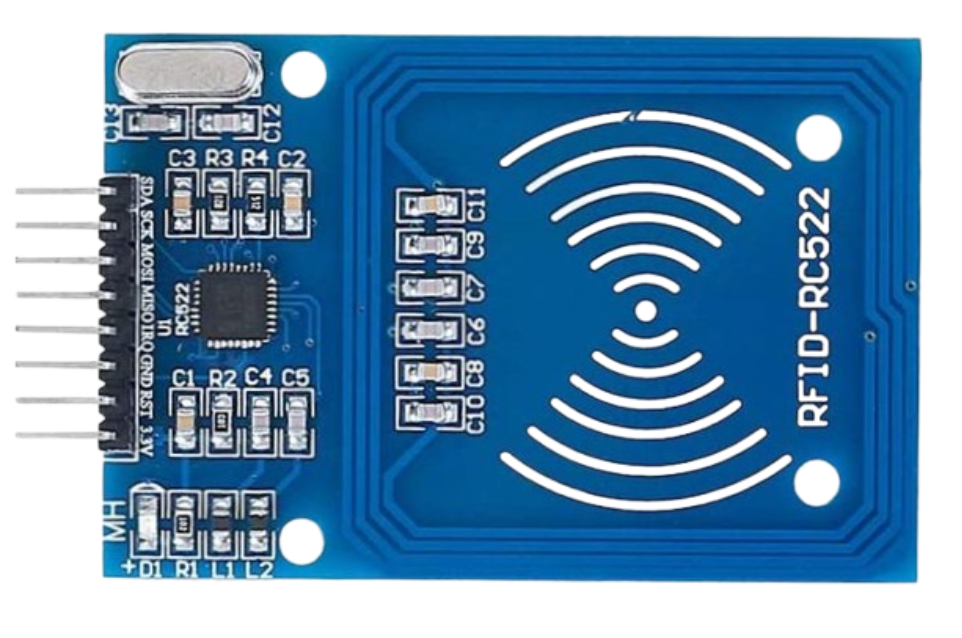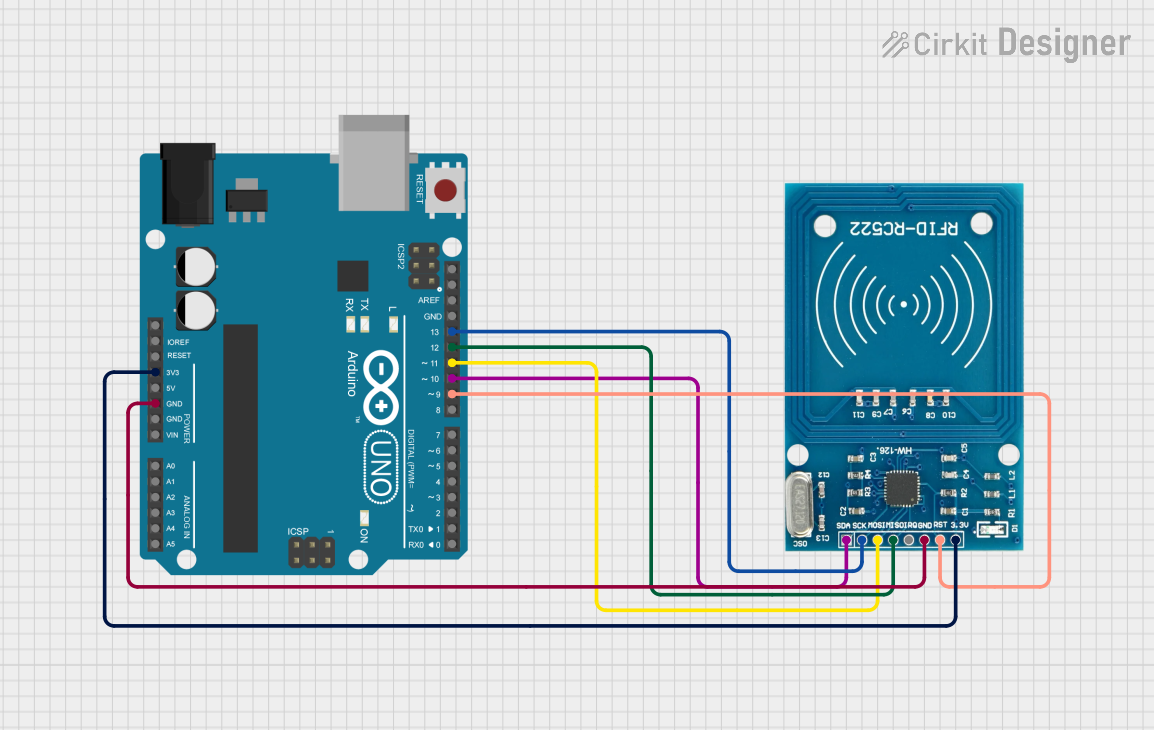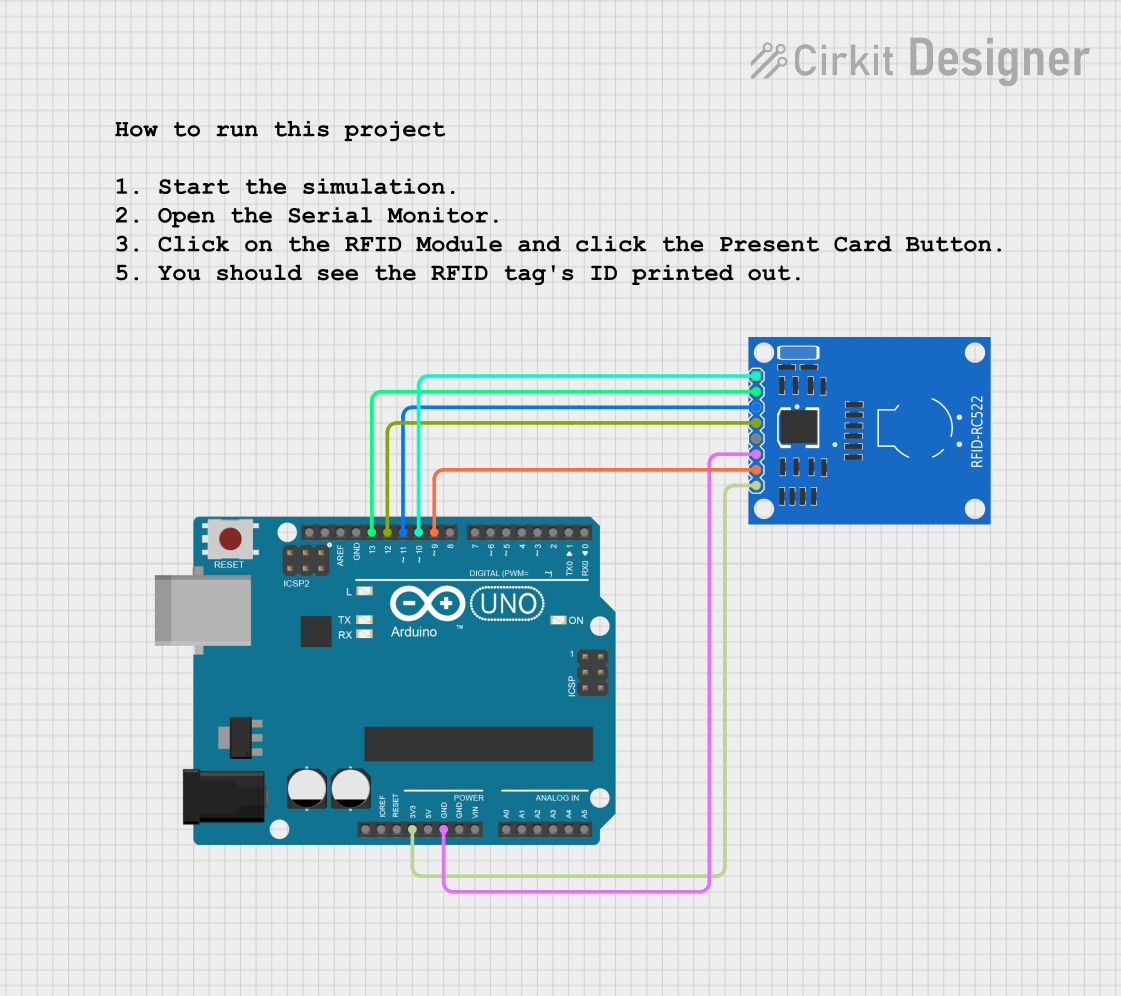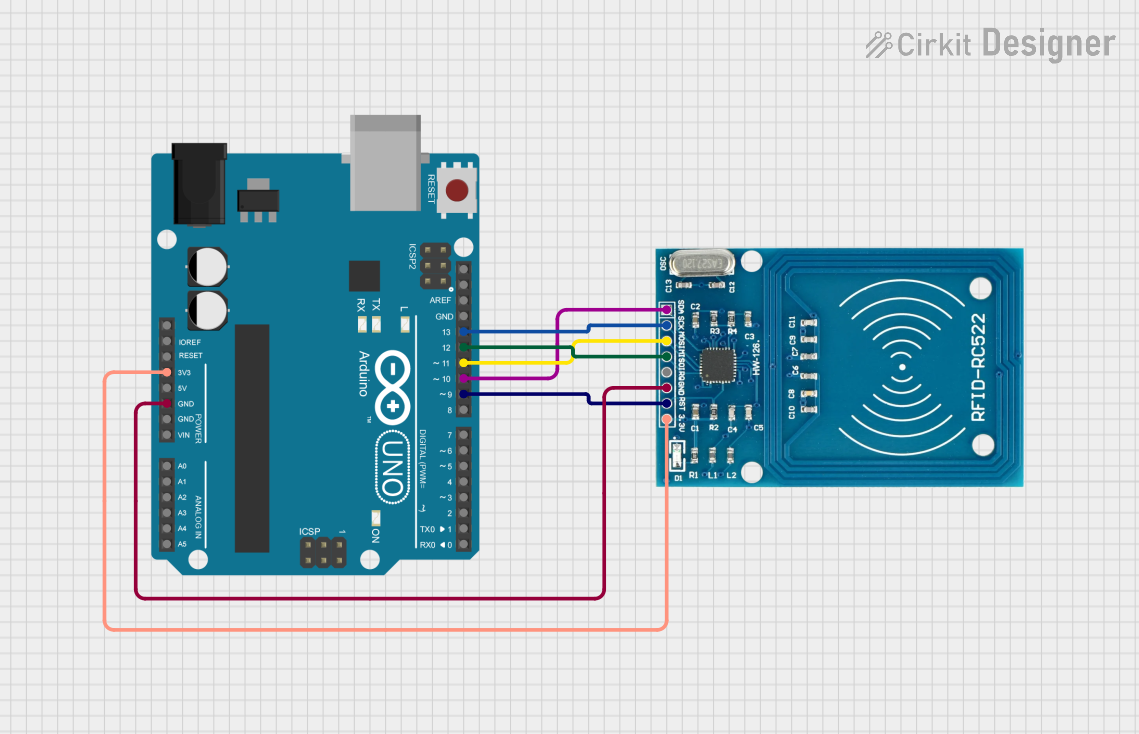
How to Use RC522 RFID Module: Examples, Pinouts, and Specs

 Design with RC522 RFID Module in Cirkit Designer
Design with RC522 RFID Module in Cirkit DesignerIntroduction
The RC522 RFID Module, manufactured by NXP Semiconductors (Part ID: MFRC522-based RC522 Module), is a compact and cost-effective device designed for reading and writing RFID tags. Operating at a frequency of 13.56 MHz, it supports communication with a variety of RFID cards and tags, including MIFARE cards. This module is widely used in applications such as:
- Access control systems (e.g., door locks, attendance systems)
- Inventory management (e.g., tracking assets or goods)
- Contactless payment systems
- IoT projects requiring RFID-based identification
Its small size, low power consumption, and SPI communication interface make it an excellent choice for integration into microcontroller-based systems, including Arduino projects.
Explore Projects Built with RC522 RFID Module

 Open Project in Cirkit Designer
Open Project in Cirkit Designer
 Open Project in Cirkit Designer
Open Project in Cirkit Designer
 Open Project in Cirkit Designer
Open Project in Cirkit Designer
 Open Project in Cirkit Designer
Open Project in Cirkit DesignerExplore Projects Built with RC522 RFID Module

 Open Project in Cirkit Designer
Open Project in Cirkit Designer
 Open Project in Cirkit Designer
Open Project in Cirkit Designer
 Open Project in Cirkit Designer
Open Project in Cirkit Designer
 Open Project in Cirkit Designer
Open Project in Cirkit DesignerTechnical Specifications
Key Technical Details
| Parameter | Value |
|---|---|
| Operating Frequency | 13.56 MHz |
| Communication Protocol | SPI, I2C, UART (default: SPI) |
| Operating Voltage | 2.5V to 3.3V (logic level) |
| Power Supply Voltage | 3.3V |
| Current Consumption | 13-26 mA (active mode) |
| Maximum Data Rate | 10 Mbps |
| Supported RFID Standards | ISO/IEC 14443 A/MIFARE |
| Reading Distance | Up to 5 cm (depending on tag type) |
| Dimensions | 40mm x 60mm |
Pin Configuration and Descriptions
The RC522 RFID Module has 8 pins for interfacing. Below is the pinout and description:
| Pin Name | Pin Number | Description |
|---|---|---|
| VCC | 1 | Power supply input (3.3V). |
| RST | 2 | Reset pin. Active LOW. Used to reset the module. |
| GND | 3 | Ground connection. |
| IRQ | 4 | Interrupt pin. Can be used to signal events to the microcontroller. |
| MISO | 5 | SPI Master-In-Slave-Out (data output from the module). |
| MOSI | 6 | SPI Master-Out-Slave-In (data input to the module). |
| SCK | 7 | SPI Clock. Synchronizes data transfer between the module and microcontroller. |
| SDA/SS | 8 | SPI Slave Select. Used to enable communication with the module. |
Usage Instructions
How to Use the RC522 RFID Module in a Circuit
- Power the Module: Connect the VCC pin to a 3.3V power source and the GND pin to ground.
- Connect to a Microcontroller: Use the SPI interface to connect the module to a microcontroller (e.g., Arduino UNO). The typical connections are:
- MISO → Arduino Pin 12
- MOSI → Arduino Pin 11
- SCK → Arduino Pin 13
- SDA/SS → Arduino Pin 10
- RST → Arduino Pin 9
- Install Required Libraries: For Arduino, install the "MFRC522" library from the Arduino IDE Library Manager.
- Write Code: Use the library functions to initialize the module, read RFID tags, and process data.
Example Arduino Code
Below is an example Arduino sketch to read RFID tags using the RC522 module:
#include <SPI.h>
#include <MFRC522.h>
// Define RC522 module pins
#define RST_PIN 9 // Reset pin connected to Arduino pin 9
#define SS_PIN 10 // Slave Select pin connected to Arduino pin 10
MFRC522 rfid(SS_PIN, RST_PIN); // Create an instance of the MFRC522 class
void setup() {
Serial.begin(9600); // Initialize serial communication
SPI.begin(); // Initialize SPI bus
rfid.PCD_Init(); // Initialize the RC522 module
Serial.println("Place your RFID card near the reader...");
}
void loop() {
// Check if an RFID card is present
if (!rfid.PICC_IsNewCardPresent() || !rfid.PICC_ReadCardSerial()) {
return; // Exit if no card is detected
}
// Print the UID of the detected card
Serial.print("Card UID: ");
for (byte i = 0; i < rfid.uid.size; i++) {
Serial.print(rfid.uid.uidByte[i], HEX); // Print each byte in hexadecimal
Serial.print(" ");
}
Serial.println();
// Halt the card to stop further communication
rfid.PICC_HaltA();
}
Important Considerations and Best Practices
- Power Supply: Ensure the module is powered with 3.3V. Using 5V may damage the module.
- Reading Distance: The effective reading distance depends on the tag type and orientation. Keep the tag within 5 cm of the antenna for reliable operation.
- Interference: Avoid placing the module near metal objects or other electronic devices that may cause interference.
- Reset Pin: Use the RST pin to reset the module if it becomes unresponsive.
Troubleshooting and FAQs
Common Issues and Solutions
| Issue | Possible Cause | Solution |
|---|---|---|
| Module not responding | Incorrect wiring or loose connections | Double-check all connections and ensure proper pin mapping. |
| Unable to read RFID tags | Tag is out of range or incompatible | Ensure the tag is within 5 cm and supports ISO/IEC 14443 A/MIFARE standards. |
| Serial monitor shows garbled output | Incorrect baud rate in the Arduino sketch | Set the correct baud rate (e.g., 9600) in both the sketch and serial monitor. |
| Module overheating | Powered with 5V instead of 3.3V | Use a 3.3V power supply to avoid damage. |
| Multiple tags not detected simultaneously | Module supports only one tag at a time | Ensure only one tag is within the reading range at a time. |
FAQs
Can the RC522 module write data to RFID tags?
- Yes, the module supports both reading and writing to compatible RFID tags.
What is the maximum range of the RC522 module?
- The maximum range is approximately 5 cm, depending on the tag type and environmental conditions.
Can I use the RC522 module with a 5V microcontroller?
- Yes, but you must use a logic level shifter to convert the 5V signals to 3.3V to avoid damaging the module.
Does the module support NFC?
- The RC522 module supports ISO/IEC 14443 A, which is a subset of NFC standards. However, it is not a full NFC module.
By following this documentation, you can effectively integrate the RC522 RFID Module into your projects and troubleshoot common issues.